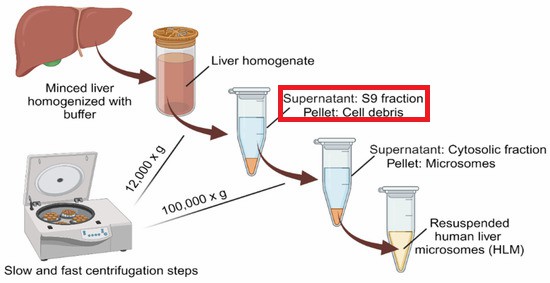S9 Stability Assay
- Service Details
- Features
- FAQ
- Explore Other Options
Metabolic stability is one of the "filters" of drug development candidates in the early stage, to determine whether they can enter the clinic. Over 60% of the preclinical candidate compounds are eventually excluded from the project due to poor metabolic behavior (e.g., too short half-life, too much first-pass effect). The cost of metabolic problems found in the middle and late stages of clinical trials is more than ten times higher than that in the early stage. Therefore, the general practice of the world's pharmaceutical and biotechnology companies is to use efficient and reliable in vitro models to predict the in vivo metabolic behavior during the lead optimization stage.
The S9 mixed enzyme system in vitro can mimic the in vivo Phase I + Phase II mixed metabolism through the extraction of cytosol (Phase II conjugation enzymes) and microsomes (Phase I CYP450 enzymes) from the liver cells in one system. It is more complete than the single microsomal model in reflecting the true metabolic fate of the compound. The main advantages are:
- Wider coverage of metabolic pathways: Particularly suitable for compounds requiring Phase II conjugation metabolism (such as carboxylic acids and phenols).
- Shorter experimental cycles: There is no need to separately conduct microsomal and hepatocyte experiments, saving over 30% of the time.
- Higher cost efficiency: Ideal for early screening of large compound libraries.

Creative Bioarray’s S9 Stability Assay Service
Workflow
Sample Preparation
Based on client requirements select the suitable S9 fraction from species like humans, mice, and rats then dilute and pre-treat them according to the needs of the experiment.

Reaction Initiation
Transfer the test compound into the reaction system with S9 fraction and cofactors (NADPH, UDPGA) and incubate after thorough mixing at 37°C.

Sample Collection
Collect samples at predetermined time points (0, 5, 15, 30, 45 minutes) and add reagents to halt the reaction instantly.

Sample Processing
Remove proteins and other impurities from stopped samples through centrifugation and filtration to extract the components that will undergo analysis

Data Analysis
Measure the parent compound concentration in samples through LC-MS/MS analysis while calculating intrinsic clearance and half-life parameters.

Protocol
| S9 Stability Assay | Details |
| S9 fractions source | Human, rat, mouse, dog, monkey (other species on request) |
| S9 concentration | 1-2 mg/mL (different concentrations available) |
| Compound concentration | 1-3 μM (different concentrations available) |
| Time points | 0,15,30,60 minutes (customizable) |
| Cofactor combination | NADPH (phase I reaction), UDPGA (phase II reaction), other custom additions |
| Controls | Negative control without co-factors Positive control: compounds with known activity |
| Analysis | UHPLC-MS/MS |
| Compound requirements | 50 μL of 10 mM DMSO stock or 1 mg solid material |
| Deliverables |
|
Why Choose Us?

Versatility
Capable of screening across multiple species, providing broad applicability for drug candidates targeting global markets.

Cost-Effectiveness
More cost-effective than using complete hepatocyte models while retaining robust metabolic analysis capabilities.

Highly Customizable
Offers personalized experimental protocols according to client needs, including flexibility in adjusting test compound concentrations, S9 fraction concentrations, and incubation time points.

Advanced Technology
Utilization of advanced analysis techniques such as LC-MS/MS ensures data accuracy and reliability.
FAQ
1. What are the advantages of using liver S9 fractions for drug metabolism studies?
Because liver S9 fractions contain multiple phase I and phase II metabolic enzymes they provide extensive evaluation of drug metabolic properties. S9 fractions offer simpler handling and storage compared to hepatocytes and display a wider range of metabolic enzymes than microsomes which positions them as the ideal choice for early-stage drug discovery studies involving phase I and II metabolism.
2. Can you provide information on metabolic products?
Yes, we can identify and characterize metabolic products using advanced analysis techniques such as LC-MS/MS. Metabolic pathway analysis and compound optimization depend fundamentally on this information.
3. What should be done if a compound shows high metabolic stability in the S9 Stability Assay?
A compound with high metabolic stability tends to remain in the body for extended periods which can lead to longer pharmacological effects. Researchers should conduct further in vitro and in vivo experiments to confirm both the therapeutic benefits and toxicological risks of the compound.
4. If my compound shows rapid metabolism in the S9 stability test, does it mean it will also be rapidly metabolized in vivo?
Although a compound demonstrates rapid metabolism in the S9 stability test suggesting high in vitro metabolic activity, this result does not guarantee the same metabolic rate will occur in vivo. The rate of in vivo metabolic processes depends on several elements such as liver blood flow and drug binding to plasma proteins along with metabolism occurring in other organs. The S9 stability test gives preliminary metabolic stability information but predicting in vivo metabolism demands combining in vitro tests like hepatocyte stability assays with in vivo experiments including animal pharmacokinetic studies.
Quotation and Ordering
Creative Bioarray's S9 stability assay can be further extended to metabolite profiling and give out more information about the metabolism of your compound. Liver microsomal stability assay and hepatocyte stability assay are also available at Creative Bioarray. Liver S9 fraction (Cat. CSC-C4093X) as a product can be used in genotoxicity tests such as Ames test as a metabolic activator. To find out more about our services and products, please feel free to leave a message below, or contact us.
Explore Other Options